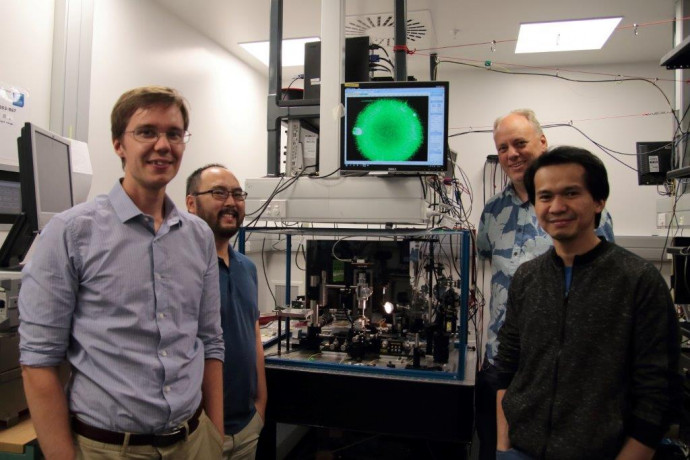Research
Published 25 November 2020New type of micro laser source suitable for commercialisation

Associate Professors Stuart Murdoch and Stephane Coen, Dr Miro Erkintalo, Dr Vincent Ng, and PhD student Noel Sayson from the Physics department at the University of Auckland have developed a new type of micro laser source
25 November 2020
This new micro laser source is capable of generating new optical frequencies tunable across the mid-infrared spectrum. This invention is cheap, tiny and suitable for commercialisation.
Lasers are everywhere in the modern world. All email and phone calls are encoded as data to be sent around the world using lasers. Lasers are used in areas ranging from surgery and the detection of disease, to precision cutting and welding, to the sensors needed for self-driving cars. Each frequency, or colour, of laser light is like a different sized spanner suited to a particular job. Yet some frequencies of light remain difficult to produce. Frequencies in the mid-infrared range are particularly difficult to generate yet needed for the sensitive detection of many chemicals, including gases such as methane and carbon-dioxide.
The team on this Marsden Fund project developed a new type of laser light source based around a tiny disk of magnesium fluoride crystal (known as an optical microresonator). When illuminated by a laser, the microresonator can transform the input laser light to a new frequency through a nonlinear process called optical parametric oscillation. While there are commercial devices available that can also achieve this, they are expensive and bulky and have struggled to find application outside of research laboratories. The device developed by this project is simple, cheap, and tiny.
For efficient operation, the microresonator must possess an ultra-high optical quality (with a roundtrip loss of the order of 1 part in 100,000 or lower). To achieve such high performance the team collaborated closely with Dr Harald Schwefel’s microresonator lab at the University of Otago. The microresonators were first cut to shape using a purpose built diamond point turning lathe, then hand-polished to the ultra-high quality optical finish required. Using these tiny devices (the smallest disk had a diameter of just 300 microns) the team was able to demonstrate tunable parametric output that spanned 2 octaves of optical frequency, from 1 to 4 microns. These ground-breaking results were published in Nature Photonics in 2019. Since this publication, other groups have also succeeded in reproducing these results across a range of different microresonator platforms. Most importantly, these include integrated photonic chip devices that offer a potential route for the future commercialisation of this technology.
RESEARCHER
Associate Professor Stuart Murdoch
ORGANISATION
University of Auckland
FUNDING SUPPORT
Marsden Fund
CONTRACT OR PROJECT ID
UOA1512: Widely-tunable optical microresonator parametric oscillators
